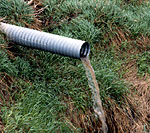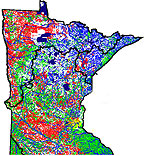By Mary Losure
Minnesota Public Radio
April 1, 2002
Minnesota has more than 20,000 miles of open farm ditches. Most were dug between 1910 and 1935 to drain millions of acres - one-fifth of the state - that were once wetlands. Today, century-old laws still allow farmers to repair, maintain, and improve this vast network, even if that means draining wetlands. Now environmental groups are filing lawsuits to challenge that, and they're winning.
| |
|
|
|
||
In Blue Earth County in southwest Minnesota, New Ulm Area Sportsfishermen President Scott Sparlin drives his truck along a rutted dirt road, pointing to a spot where willow trees stand up against the black farm fields all around.
"You see those mounds of the muskrat houses out there? Even in this dry of a year, you can see there's open water space out there. Oftentimes even when you drive by from the highway, you can't fathom how much water is held in these places," Sparlin said.
The water is still here because four years ago, the New Ulm Area Sportsfishermen and others went to court.
Blue Earth County had planned to drain this wetland, as part of project to improve the surrounding fields. Those fields are underlain by a network of pipes, much like a city's storm sewers.
The pipes drain excess water off the fields, and into the wetland. The plan was to connect the whole system to a nearby drainage ditch - like putting a bigger drain hole in a bathtub.
All the water once held in the wetland and backed up in the fields would flow into the ditch. From there, it would go into a designated trout stream, and that's where Scott Sparlin had a problem.
He says after a heavy rain, the water from farm fields is black with sediment and loaded with pesticides and fertilizers.
"This is county ditch 36. See the pipe? Now there's many people who wonder why that pipe shouldn't be covered under the 1972 Clean Water Act, as a point source of pollution. All of the pipes that go into various streams as outflow from factories and cities and so on have all been dealt with. What hasn't been dealt with is what you're looking at right there," he said during a recent tour.
Next, Sparlin drove by a stream that's officially designated as part of the Brown County ditch system. The trees that once lined the banks lie in a huge pile. The county is dredging a deeper channel, so water draining from farm fields can flow more quickly.
|
"It certainly is our preference that if state policy is going to be made, it should be made at the Capitol. Not in the courtroom."
- Dave Wierens, Association of Minnesota Counties |
Sparlin says 10 years ago, few people in farm country spoke out against projects like these, but that's starting to change.
"I think it energizes people into activity. Their fishing hole, they feel, has gone downhill," he said.
Ditch projects occur in farm counties all across the state, but no one knows the number of acres of Minnesota wetlands at risk of being drained. There is no statewide inventory, and only a handful of counties keep figures, in part because some counties fear environmental groups may use the information to try to stop drainage projects.
A staff member at the state agency that oversees wetlands - the Board of Water and Soil Resources - calls the situation an "information void." He says the figure may be tens of thousands - or even hundreds of thousands - of acres, many of them on the state's western border.
In the past few years, ditch project opponents and a Twin Cities-based environmental group, the Minnesota Center for Environmental Advocacy, have filed five successful lawsuits against drainage projects, and settled three more out of court.
Attorney Noah Hall says the center filed the cases as part of a deliberate legal strategy to reshape drainage practices in Minnesota.
"We've had hundreds of calls from citizens around the state complaining about various drainage projects in the counties that they live in," according to Hall. "When we decide which case to bring, we look for cases with statewide implications and cases with significant environmental impact."
In January, the center won what Hall calls a landmark victory when the Minnesota Court of Appeals ruled that despite the ditch laws, commissioners in Big Stone County could not drain a 66-acre wetland without getting a permit from the state Department of Natural Resources and doing detailed environmental studies.
Big Stone County and the Association of Minnesota Counties have appealed the case to the Minnesota Supreme Court.
| |
|
|
|
||
The association's Dave Wierens says counties are worried that if ditch projects have to get DNR permission and do environmental review, many of them will be unworkable under the ditch laws.
"There is an issue of the damages - the costs - cannot exceed the benefits of a ditch project. To the extent you increase costs, you may cross that line, and then the project cannot go forward," according to Wierens.
Wierens says counties need flexibility to deal with the complex and often contentious issues surrounding drainage projects. He points out that when Minnesota enacted its 1991 Wetland Conservation Act, it was a compromise between the old ditch laws and new protections. He says the law was not designed to disable the ditch system, which is critical to agriculture in much of Minnesota.
"The intent has always been to allow for ditch repairs... to go forward with minimal regulatory intervention. This court case throws that intention out. And that gets back to another issue. It certainly is our preference that if state policy is going to be made, it should be made at the Capitol. Not in the courtroom," Wierens said.
Attorney John Kolb, who handles many drainage cases for counties, says environmentalists and farmers can find a middle ground. He says often there are technical solutions, such as low dams, that will preserve wetlands and still allow farmers to drain surrounding fields. But he says wetland preservationists have to be willing to share the costs, not just dump them onto landowners.
"Suppose now because of the environmental regulations I can't repair the ditch, and I have 100 acres that I used to farm with no problem, that are suddenly underwater. What am I supposed to do? Am I supposed to just walk away from that and allow that to be brand new wetland for the benefit of everyone in the state? Or do I somehow get compensated for that?" Kolb said.
Minnesota has some programs to pay farmers to preserve wetlands threatened by ditch projects, but they have not been funded in recent years.
Right now, state wetlands dollars are being used largely to restore wetlands that have already been drained, not to preserve the ones that remain.
More Information

